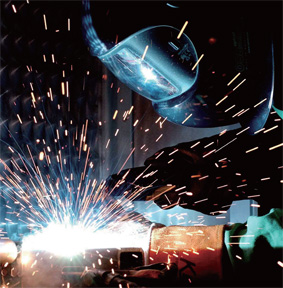 On the job or in the garage, every welder needs protection to prevent eye damage. As a general rule, spending more on a welding helmet will increase comfort, improve your welding ability, result in higher-quality welds and ensure your safety. Unfortunately, selecting a helmet can be confusing if you're not familiar with the latest auto-darkening lens technology and national safety standards. The first question to ask when buying a welding helmet is which type of lens is right for you. Standard or passive welding helmets are as common today as they were 50 years ago. The viewing lens or filter is a special piece of dark tinted glass, most often with a #10 shade and ultraviolet (UV) and infrared (IR) coatings. When the welder is ready to begin welding, a quick nod, or snap of the neck flips the helmet down before striking an arc. When finished, the welder reaches to pivot the helmet up and away from his face to view the workpiece and to reposition for the next weld. Although inexpensive, standard helmets have several disadvantages: it is difficult to keep the gun/torch in the correct position to begin welding after lowering the helmet in place, especially for beginners; when welding in restricted spaces, such as under cars or trailers, there isn't enough room to flip a helmet up and down; the repetitive task of flipping up and down causes neck discomfort after a day of welding; and, finally, lifting and lowering a helmet is inefficient especially while doing a lot of tack welding. Auto-darkening welding helmets resolve all of these problems. Instead of a standard piece of tinted glass, helmets with auto-darkening filters have an electronic filter lens and often are equipped with adjustable features to make welding easy. The auto-darkening filter (ADF) lens is a special liquid crystal display (LCD) that is similar in design to the technology used to display numbers on a digital alarm clock. Most filter cartridges are powered by a combination of battery and solar power. Several light sensors are mounted near the lens to detect the welding arc. When the lens is not activated, an auto-darkening LCD filter usually has #3 or #4 shade, which is relatively easy to see through, similar to sunglasses. This makes arc starts easier because the welder can see the position of his MIG gun, TIG torch or stick electrode relative to the material he is welding. Once an arc is initiated, sensors on the helmet darken the lens to a shade #9 to #13, depending on the settings, hundreds of times faster than you can blink an eye. Since the filter has UV and IR coatings applied to it, eyes are protected from harmful rays regardless of active/inactive shade setting. Best of all, the helmet stays down before, during and after the job is being done. Autodarkening welding helmets enable you to setup a welding joint with the hood in position. No more head snaps to lower the helmet. No more sloppy starts because the torch moved. If most of your welding involves one type of material, such as steel, of the same thickness, using the same welding process, such as stick, at the same amperage, then a fixed shade #10 lens is all you'll ever need. Standard glass lens helmets obviously are fixed shade, and the least expensive auto-darkening helmets also are available in fixed shade. However, most people weld different materials, such as mild steel, stainless steels, and aluminum, and with different thicknesses that require the use of different welding processes, such as stick, MIG and TIG, for specific jobs. That means the welding amperage can vary from 40amps to more than 200amps. With that variance comes varying degrees of brightness in the arc. To properly protect your eyes and get the best view of the weld puddle, you need to have an adjustable or variable shade lens. These adjustments are found either inside the helmet on the lens, or outside on the side of the helmetAir Jordan
On the job or in the garage, every welder needs protection to prevent eye damage. As a general rule, spending more on a welding helmet will increase comfort, improve your welding ability, result in higher-quality welds and ensure your safety. Unfortunately, selecting a helmet can be confusing if you're not familiar with the latest auto-darkening lens technology and national safety standards. The first question to ask when buying a welding helmet is which type of lens is right for you. Standard or passive welding helmets are as common today as they were 50 years ago. The viewing lens or filter is a special piece of dark tinted glass, most often with a #10 shade and ultraviolet (UV) and infrared (IR) coatings. When the welder is ready to begin welding, a quick nod, or snap of the neck flips the helmet down before striking an arc. When finished, the welder reaches to pivot the helmet up and away from his face to view the workpiece and to reposition for the next weld. Although inexpensive, standard helmets have several disadvantages: it is difficult to keep the gun/torch in the correct position to begin welding after lowering the helmet in place, especially for beginners; when welding in restricted spaces, such as under cars or trailers, there isn't enough room to flip a helmet up and down; the repetitive task of flipping up and down causes neck discomfort after a day of welding; and, finally, lifting and lowering a helmet is inefficient especially while doing a lot of tack welding. Auto-darkening welding helmets resolve all of these problems. Instead of a standard piece of tinted glass, helmets with auto-darkening filters have an electronic filter lens and often are equipped with adjustable features to make welding easy. The auto-darkening filter (ADF) lens is a special liquid crystal display (LCD) that is similar in design to the technology used to display numbers on a digital alarm clock. Most filter cartridges are powered by a combination of battery and solar power. Several light sensors are mounted near the lens to detect the welding arc. When the lens is not activated, an auto-darkening LCD filter usually has #3 or #4 shade, which is relatively easy to see through, similar to sunglasses. This makes arc starts easier because the welder can see the position of his MIG gun, TIG torch or stick electrode relative to the material he is welding. Once an arc is initiated, sensors on the helmet darken the lens to a shade #9 to #13, depending on the settings, hundreds of times faster than you can blink an eye. Since the filter has UV and IR coatings applied to it, eyes are protected from harmful rays regardless of active/inactive shade setting. Best of all, the helmet stays down before, during and after the job is being done. Autodarkening welding helmets enable you to setup a welding joint with the hood in position. No more head snaps to lower the helmet. No more sloppy starts because the torch moved. If most of your welding involves one type of material, such as steel, of the same thickness, using the same welding process, such as stick, at the same amperage, then a fixed shade #10 lens is all you'll ever need. Standard glass lens helmets obviously are fixed shade, and the least expensive auto-darkening helmets also are available in fixed shade. However, most people weld different materials, such as mild steel, stainless steels, and aluminum, and with different thicknesses that require the use of different welding processes, such as stick, MIG and TIG, for specific jobs. That means the welding amperage can vary from 40amps to more than 200amps. With that variance comes varying degrees of brightness in the arc. To properly protect your eyes and get the best view of the weld puddle, you need to have an adjustable or variable shade lens. These adjustments are found either inside the helmet on the lens, or outside on the side of the helmetAir JordanWhat you need to know when buying welding helmets
Source: Release Date:2010-07-01 220
 On the job or in the garage, every welder needs protection to prevent eye damage. As a general rule, spending more on a welding helmet will increase comfort, improve your welding ability, result in higher-quality welds and ensure your safety. Unfortunately, selecting a helmet can be confusing if you're not familiar with the latest auto-darkening lens technology and national safety standards. The first question to ask when buying a welding helmet is which type of lens is right for you. Standard or passive welding helmets are as common today as they were 50 years ago. The viewing lens or filter is a special piece of dark tinted glass, most often with a #10 shade and ultraviolet (UV) and infrared (IR) coatings. When the welder is ready to begin welding, a quick nod, or snap of the neck flips the helmet down before striking an arc. When finished, the welder reaches to pivot the helmet up and away from his face to view the workpiece and to reposition for the next weld. Although inexpensive, standard helmets have several disadvantages: it is difficult to keep the gun/torch in the correct position to begin welding after lowering the helmet in place, especially for beginners; when welding in restricted spaces, such as under cars or trailers, there isn't enough room to flip a helmet up and down; the repetitive task of flipping up and down causes neck discomfort after a day of welding; and, finally, lifting and lowering a helmet is inefficient especially while doing a lot of tack welding. Auto-darkening welding helmets resolve all of these problems. Instead of a standard piece of tinted glass, helmets with auto-darkening filters have an electronic filter lens and often are equipped with adjustable features to make welding easy. The auto-darkening filter (ADF) lens is a special liquid crystal display (LCD) that is similar in design to the technology used to display numbers on a digital alarm clock. Most filter cartridges are powered by a combination of battery and solar power. Several light sensors are mounted near the lens to detect the welding arc. When the lens is not activated, an auto-darkening LCD filter usually has #3 or #4 shade, which is relatively easy to see through, similar to sunglasses. This makes arc starts easier because the welder can see the position of his MIG gun, TIG torch or stick electrode relative to the material he is welding. Once an arc is initiated, sensors on the helmet darken the lens to a shade #9 to #13, depending on the settings, hundreds of times faster than you can blink an eye. Since the filter has UV and IR coatings applied to it, eyes are protected from harmful rays regardless of active/inactive shade setting. Best of all, the helmet stays down before, during and after the job is being done. Autodarkening welding helmets enable you to setup a welding joint with the hood in position. No more head snaps to lower the helmet. No more sloppy starts because the torch moved. If most of your welding involves one type of material, such as steel, of the same thickness, using the same welding process, such as stick, at the same amperage, then a fixed shade #10 lens is all you'll ever need. Standard glass lens helmets obviously are fixed shade, and the least expensive auto-darkening helmets also are available in fixed shade. However, most people weld different materials, such as mild steel, stainless steels, and aluminum, and with different thicknesses that require the use of different welding processes, such as stick, MIG and TIG, for specific jobs. That means the welding amperage can vary from 40amps to more than 200amps. With that variance comes varying degrees of brightness in the arc. To properly protect your eyes and get the best view of the weld puddle, you need to have an adjustable or variable shade lens. These adjustments are found either inside the helmet on the lens, or outside on the side of the helmetAir Jordan
On the job or in the garage, every welder needs protection to prevent eye damage. As a general rule, spending more on a welding helmet will increase comfort, improve your welding ability, result in higher-quality welds and ensure your safety. Unfortunately, selecting a helmet can be confusing if you're not familiar with the latest auto-darkening lens technology and national safety standards. The first question to ask when buying a welding helmet is which type of lens is right for you. Standard or passive welding helmets are as common today as they were 50 years ago. The viewing lens or filter is a special piece of dark tinted glass, most often with a #10 shade and ultraviolet (UV) and infrared (IR) coatings. When the welder is ready to begin welding, a quick nod, or snap of the neck flips the helmet down before striking an arc. When finished, the welder reaches to pivot the helmet up and away from his face to view the workpiece and to reposition for the next weld. Although inexpensive, standard helmets have several disadvantages: it is difficult to keep the gun/torch in the correct position to begin welding after lowering the helmet in place, especially for beginners; when welding in restricted spaces, such as under cars or trailers, there isn't enough room to flip a helmet up and down; the repetitive task of flipping up and down causes neck discomfort after a day of welding; and, finally, lifting and lowering a helmet is inefficient especially while doing a lot of tack welding. Auto-darkening welding helmets resolve all of these problems. Instead of a standard piece of tinted glass, helmets with auto-darkening filters have an electronic filter lens and often are equipped with adjustable features to make welding easy. The auto-darkening filter (ADF) lens is a special liquid crystal display (LCD) that is similar in design to the technology used to display numbers on a digital alarm clock. Most filter cartridges are powered by a combination of battery and solar power. Several light sensors are mounted near the lens to detect the welding arc. When the lens is not activated, an auto-darkening LCD filter usually has #3 or #4 shade, which is relatively easy to see through, similar to sunglasses. This makes arc starts easier because the welder can see the position of his MIG gun, TIG torch or stick electrode relative to the material he is welding. Once an arc is initiated, sensors on the helmet darken the lens to a shade #9 to #13, depending on the settings, hundreds of times faster than you can blink an eye. Since the filter has UV and IR coatings applied to it, eyes are protected from harmful rays regardless of active/inactive shade setting. Best of all, the helmet stays down before, during and after the job is being done. Autodarkening welding helmets enable you to setup a welding joint with the hood in position. No more head snaps to lower the helmet. No more sloppy starts because the torch moved. If most of your welding involves one type of material, such as steel, of the same thickness, using the same welding process, such as stick, at the same amperage, then a fixed shade #10 lens is all you'll ever need. Standard glass lens helmets obviously are fixed shade, and the least expensive auto-darkening helmets also are available in fixed shade. However, most people weld different materials, such as mild steel, stainless steels, and aluminum, and with different thicknesses that require the use of different welding processes, such as stick, MIG and TIG, for specific jobs. That means the welding amperage can vary from 40amps to more than 200amps. With that variance comes varying degrees of brightness in the arc. To properly protect your eyes and get the best view of the weld puddle, you need to have an adjustable or variable shade lens. These adjustments are found either inside the helmet on the lens, or outside on the side of the helmetAir Jordan
You May Like














